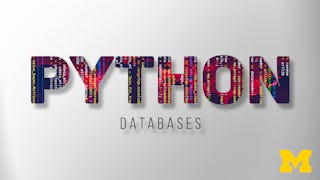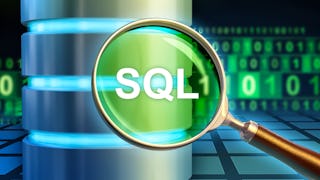Este curso presentará a los estudiantes los conceptos básicos del lenguaje de consulta estructurado (Structured Query Language, SQL), así como el diseño básico de bases de datos para almacenar datos como parte de una iniciativa de varios pasos para recopilar, analizar y procesar datos. El curso utilizará SQLite3 como base de datos. También crearemos rastreadores web y procesos de visualización y recopilación de datos de varios pasos. Utilizaremos la biblioteca D3.js para realizar la visualización básica de datos. Este curso abarcará los capítulos de 14 y 15 del libro “Python para todos”. Para que le vaya bien en este curso, debe estar familiarizado con el material cubierto en los capítulos 1 a 13 del libro de texto y los primeros tres cursos de esta especialización. Este curso abarca Python 3.

Genießen Sie unbegrenztes Wachstum mit einem Jahr Coursera Plus für 199 $ (regulär 399 $). Jetzt sparen.

Uso de bases de datos con Python

Dozent: Charles Russell Severance
2.279 bereits angemeldet
Bei enthalten
Was Sie lernen werden
Utilizar las operaciones crear, leer, actualizar y eliminar para administrar bases de datos
Explicar los conceptos básicos de Python orientado a objetos
Comprender cómo se almacenan los datos en varias tablas de una base de datos
Utilizar la API de Google Maps para visualizar datos
Kompetenzen, die Sie erwerben
- Kategorie: Database Design
- Kategorie: Databases
- Kategorie: SQL
- Kategorie: Data Collection
- Kategorie: Object Oriented Programming (OOP)
- Kategorie: Relational Databases
- Kategorie: Database Management
- Kategorie: Web Applications
- Kategorie: Data Modeling
- Kategorie: Data Visualization Software
- Kategorie: Web Scraping
- Kategorie: Python Programming
- Kategorie: Web Development
- Kategorie: Data Processing
Wichtige Details

Zu Ihrem LinkedIn-Profil hinzufügen
5 Aufgaben
Erfahren Sie, wie Mitarbeiter führender Unternehmen gefragte Kompetenzen erwerben.

In diesem Kurs gibt es 5 Module
Para comenzar esta clase, cubrimos los aspectos básicos de Python orientado a objetos. No escribiremos nuestros propios objetos, pero dado que muchas de las cosas que usamos, como BeautifulSoup, cadenas, diccionarios y conexiones a bases de datos, utilizan patrones orientados a objetos (Object Oriented, OO) al menos comprenderemos algo de sus patrones y terminología.
Das ist alles enthalten
12 Videos4 Lektüren2 Aufgaben
Aprenderemos las cuatro operaciones principales CRUD (Create, Read, Update, Delete [crear, leer, actualizar y eliminar]) para administrar los datos almacenados en una base de datos.
Das ist alles enthalten
7 Videos1 Aufgabe2 App-Elemente
En esta sección, aprenderemos cómo se almacenan los datos en varias tablas de una base de datos y cómo se vinculan las filas (es decir, estableceremos relaciones) en la base de datos.
Das ist alles enthalten
8 Videos1 Aufgabe1 App-Element
En esta sección exploramos cómo modelar situaciones tales como estudiantes que se inscriben en cursos en los que cada curso tiene varios estudiantes y cada estudiante está inscrito en varios cursos.
Das ist alles enthalten
5 Videos1 Aufgabe1 App-Element
En esta sección, reunimos todo, recuperamos y procesamos algunos datos y luego usamos la API de Google Maps para visualizar nuestros datos.
Das ist alles enthalten
6 Videos4 Lektüren1 App-Element
Dozent

Mehr von Software Development entdecken
- Status: Kostenloser Testzeitraum

University of Michigan
- Status: Kostenloser Testzeitraum
Warum entscheiden sich Menschen für Coursera für ihre Karriere?





Neue Karrieremöglichkeiten mit Coursera Plus
Unbegrenzter Zugang zu 10,000+ Weltklasse-Kursen, praktischen Projekten und berufsqualifizierenden Zertifikatsprogrammen - alles in Ihrem Abonnement enthalten
Bringen Sie Ihre Karriere mit einem Online-Abschluss voran.
Erwerben Sie einen Abschluss von erstklassigen Universitäten – 100 % online
Schließen Sie sich mehr als 3.400 Unternehmen in aller Welt an, die sich für Coursera for Business entschieden haben.
Schulen Sie Ihre Mitarbeiter*innen, um sich in der digitalen Wirtschaft zu behaupten.
Häufig gestellte Fragen
To access the course materials, assignments and to earn a Certificate, you will need to purchase the Certificate experience when you enroll in a course. You can try a Free Trial instead, or apply for Financial Aid. The course may offer 'Full Course, No Certificate' instead. This option lets you see all course materials, submit required assessments, and get a final grade. This also means that you will not be able to purchase a Certificate experience.
When you purchase a Certificate you get access to all course materials, including graded assignments. Upon completing the course, your electronic Certificate will be added to your Accomplishments page - from there, you can print your Certificate or add it to your LinkedIn profile.
Yes. In select learning programs, you can apply for financial aid or a scholarship if you can’t afford the enrollment fee. If fin aid or scholarship is available for your learning program selection, you’ll find a link to apply on the description page.
Weitere Fragen
Finanzielle Unterstützung verfügbar,


